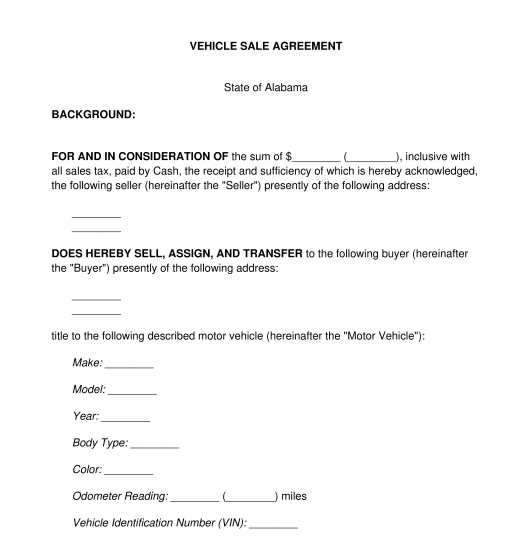 10/28/2025
10/28/2025

Answer a few questions and your document is created automatically.

Your document is ready! You will receive it in Word and PDF formats. You will be able to modify it.




Rating: 4.8 - 1,037 votes
Download a basic template (FREE) Create a customized documentA vehicle sale agreement is a document that can be used to lay out the details of the sale of a vehicle (e.g., a car, truck, van, motorcycle, boat, etc.) from a seller to a buyer. Using this agreement, the buyer and seller can outline the terms and conditions of the sale.
This vehicle sale agreement can only be used to sell a four-wheeled vehicle, motorcycle, or boat.
By contrast, a property sale agreement is to be used for the sale of residential or commercial property, such as a home, office building, or plot of land.
No, a vehicle sale agreement is not necessary. The process of selling a vehicle only requires that the title to the vehicle be transferred from the buyer to the seller.
However, though a vehicle sale agreement is not necessary, it is highly advisable to create one as it works to make sure both parties understand the details of the sale. It acts as protection for one or both of the parties in case there is a problem or future dispute related to the sale.
A vehicle identification number, commonly referred to as a VIN, is a unique number assigned to every vehicle. The VIN is located in numerous places both on the vehicle as well as on the titles, insurance policies, and service records for the vehicle. A hull identification number, also known as a HIN, is the equivalent unique number for a boat.
Prior to the sale of a used vehicle, the potential buyer should do their due diligence in researching the background of the vehicle. They can use a service such as CARFAX to get a vehicle history report. This report contains information about past accidents, the status of the vehicle's title, and other important information. The potential buyer may also elect to use trusted mechanic to check the condition of the vehicle and uncover any hidden issues before they purchase it.
Once the document is complete, both the buyer and seller should sign and date the vehicle sale agreement. In most states, the document does not need to be notarized or witnessed in order to be legally binding. However, in Louisiana, Maryland, Wyoming, Nebraska, and West Virginia the document should be signed in front of a notary and the notary should complete the included notarization page for the agreement to be legally binding on the parties.
The parties should each save a copy of the vehicle sale agreement in their files for future reference and in case of dispute or disagreement. Once this document has been completed, the seller should transfer the title to the vehicle to the buyer in the manner required by the state in which the car will be located after purchase. More information about this process can be found on the state's Department of Motor Vehicles website.
In most states, it is not necessary to notarize a vehicle sale agreement. . However, in Louisiana, Maryland, Wyoming, Nebraska, and West Virginia the document should be signed in front of a notary and the notary should complete the included notarization page for the agreement to be legally binding on the parties.
A valid vehicle sale agreement must contain at least the following mandatory sections:
Vehicle sale agreements, like general purpose sale agreements, in the United States are generally subject to both federal law and state specific laws, which cover general contract principles like formation and mutual understanding. Federal law dictates that a vehicle sale agreement must include a disclosure by the seller of the vehicle's odometer reading at the time of the sale. Further, state laws cover commercial transactions and business. For example, in Louisiana, Maryland, Nebraska, Wyoming, and West Virginia, a vehicle sales agreement must be certified by a notary.
You fill out a form. The document is created before your eyes as you respond to the questions.
At the end, you receive it in Word and PDF formats. You can modify it and reuse it.
Guides to help you
Vehicle Sale Agreement - FREE - Template - Word and PDF
Country: United States